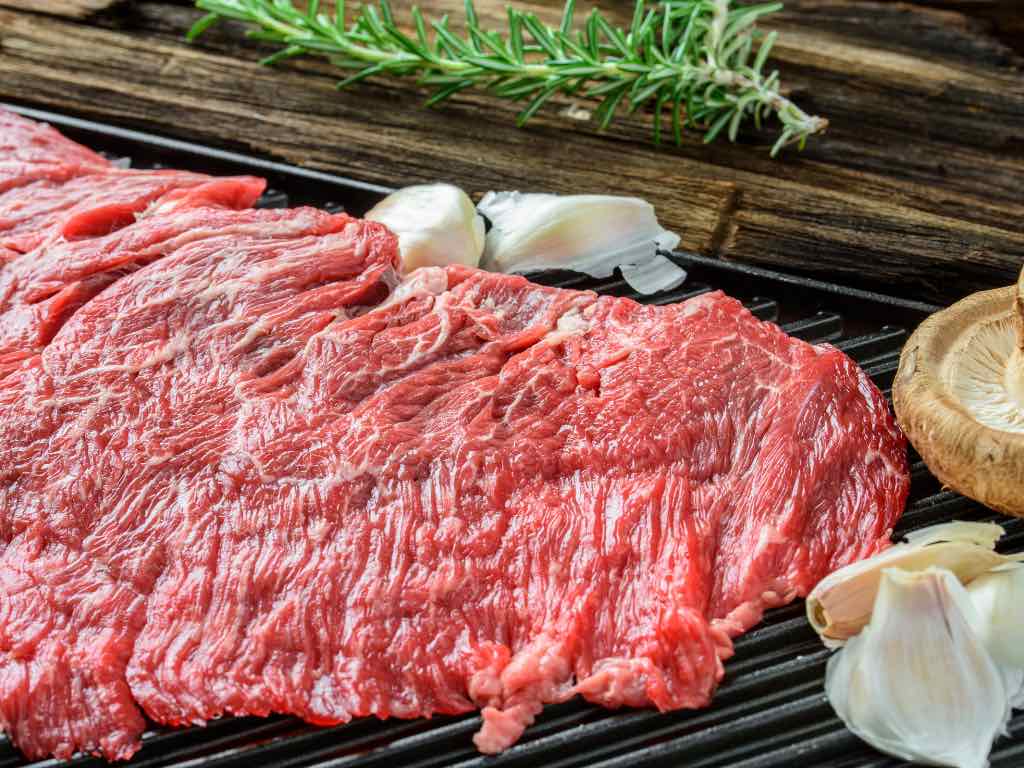
Mastering What is Flap Meat: Cooking Tips & Delicious Recipe
|
|
Time to read 5 min
Welcome to One Stop Halal!
Written by: Samir P.
|
|
Time to read 5 min
Flap meat, often called flap steak, is a term that might not be immediately recognizable to the average consumer but is well-known among culinary enthusiasts and professional chefs. This cut of beef is celebrated for its robust flavor, versatility in cooking, and affordability. In this blog, we will discuss what is flap meat, its characteristics, how it compares to similar cuts, and the best ways to prepare and enjoy it.
Flap meat comes from the bottom sirloin butt, located in the hindquarter of the cow. Specifically, it is part of the short loin and flank sections, nestled between the flank and the sirloin. This area is known for its hardworking muscles, which results in a cut that is both flavorful and somewhat fibrous.
Flap meat is known for its coarse texture and rich marbling, contributing to its pronounced beefy flavor. The muscle fibers are long and somewhat loosely packed, making it a relatively tender cut when cooked properly. This marbling and texture mean it can absorb marinades well and benefit from various cooking methods.
Flank Steak need clarification due to its proximity to the cow and similar applications in cooking. However, they have distinct differences:
Skirt steak is another popular cut that is often compared to flap meat:
Hanger steak is another flavorful cut that comes from the lower belly of the cow:
Given its texture and marbling, flap meat is an excellent candidate for marination. A good marinade not only adds flavor but also helps tenderize the meat. Popular marinade ingredients include:
These include lime juice, lemon juice and vinegar, which help break down muscle fibers.
Olive or another neutral oil helps moisten the meat during cooking.
Garlic, soy sauce, Worcestershire sauce, herbs, and spices add depth to the flavor profile.
Grilling is one of the most popular methods for cooking flap meat. Here’s how to do it:
Pan-searing is another excellent way to cook flap meat, especially if you don’t have access to a grill:
For an indoor alternative that mimics the grill, broiling is a good choice:
Flap meat can also be used in stir-fries:
Flap meat is perfect for tacos. The marinated, grilled, and sliced beef fits perfectly into a warm tortilla, topped with fresh salsa, guacamole, and cilantro.
Like tacos, fajitas are another excellent use for flap meat. Serve the sliced meat with sautéed bell peppers, onions, warm tortillas, and various toppings.
Sliced flap meat can elevate a salad, adding a hearty, protein-rich component. Pair it with greens, cherry tomatoes, avocados, and a tangy vinaigrette.
Flap meat makes for an excellent steak sandwich. Slice it thin and serve on a crusty roll with arugula, caramelized onions, and a smear of horseradish sauce.
Pair flap meat with grains like quinoa or rice, roasted vegetables, and a flavorful sauce or dressing to create a nutritious bowl.
Flap meat, like other cuts of beef, is a good source of protein, essential amino acids, vitamins, and minerals. It is vibrant in:
However, it is also important to note that flap meat contains saturated fat, so it should be consumed in moderation as part of a balanced diet.
When buying flap meat, look for pieces with a good amount of marbling and a fresh, deep red color. Avoid any meat that looks dry or has an off odor.
Welcome to your favorite butcher shop. We carry custom cuts of beef, chicken, lamb, goat, grass-fed beef, wagyu, deli, and more. We ship across the United States in 1-2 business days.
What is beef flap meat? While less widely known than other cuts, it is a hidden gem in beef. Its rich flavor, versatility, and relative affordability make it a fantastic option for various dishes. Whether you're grilling, pan-searing, broiling, or stir-frying, flap meat can be a delicious addition to your culinary repertoire. By understanding its characteristics and best cooking practices, you can make the most of this flavorful cut and impress your family and friends with delicious, tender, and juicy meals.

© 2026 One Stop Halal, Inc.